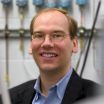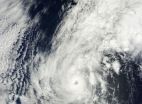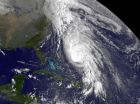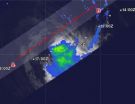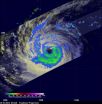(Press-News.org) Though not often considered beyond the plasma television, small-scale microplasmas have great utility in a wide variety of applications. Recently, new developments have begun to capitalize on how these microplasmas interact with liquids in applications ranging from killing bacteria for sterilizing a surface to rapidly synthesizing nanoparticles.
An interdisciplinary collaboration between researchers at Case Western Reserve University and the University of Notre Dame has revealed a critical interaction that is occurring at this plasma-liquid interface in that the electrons in plasma actually serve to separate water, producing hydrogen gas.
In a paper set to appear as a Fast Track Communication in the Journal of Physics D: Applied Physics, David B. Go, assistant professor of aerospace and mechanical engineering at the University of Notre Dame, and his graduate student Paul Rumbach teamed with R. Mohan Sankaran, associate professor of chemical engineering at Case Western Reserve, and his undergraduate student Megan Witzke describe a series of experiments that revealed this new chemistry.
A plasma is an ionized gas, consisting of not only neutral gas molecules but also free electrons and charged ions. Though often thought of as very hot, microplasmas are a unique regime of plasmas that can be formed at atmospheric pressure and are considered "cold plasmas" because they are typically around room temperature. In most plasma-liquid studies, the focus has been on how the different gas species and photons (light) produced by the plasma interact with the liquid.
"Many researchers have revealed that reactive oxygen and nitrogen species in the plasma play an important role in the plasma-liquid interaction," Sankaran said, "But we've always thought that the electrons must be playing an important part. We had preliminary evidence that suggested that the plasma electrons would reduce various chemical species in the liquid but always believed that they must have been interacting with water as well. This study conclusively proves that the electrons directly interact with and electrolyze water."
Water electrolysis is the splitting of water into oxygen and hydrogen and usually occurs in an electrochemical cell with two metals electrodes. In their work Go and Sankaran replaced one of the metal electrodes with an atmospheric-pressure plasma jet. However, the result was that the plasma electrochemical cell acted like a traditional electrochemical cell.
"We found that at the plasma-liquid interface, the plasma formed a virtual cathode and electrons from the plasma reduced hydrogen ions to produce hydrogen gas while at the metal anode, oxidation formed oxygen gas. The reactions are the same as for a traditional electrochemical cell, except now the plasma jet plays the role of one of the electrodes," Go said.
While Go and Sankaran acknowledge that the plasma-liquid interaction is an incredibly complex phenomenon, they agree that this work fills in a crucial piece of the puzzle.
"As we continue to develop plasma jets for all kinds of applications, be they medical, environmental or for synthesizing materials," Go said. "It's crucial that we understand the fundamental chemistry that is occurring. The role of electrons has been somewhat overlooked, but we show that they play an important role and must be considered as we continue to try to understand these new microplasma devices."
Much of this work was conducted with support from the Air Force Office of Scientific Research. Both Go and Sankaran are recent recipients of the AFOSR's Young Investigator Award.
INFORMATION:
END
No matter which way you look at it, rejection hurts. Experiencing rejection from a boss, a friend, or a partner is difficult enough for many adults to handle. But adolescents, who are dealing with the one-two punch of biological and social change, may be the most vulnerable to its negative effects.
In a new study published in Clinical Psychological Science, a journal of the Association for Psychological Science, researcher Michael Murphy and colleagues examine the human immune response as a potential link between social stressors like rejection and later mental and physical ...
Cambridge, Mass. - October 16, 2012 - Atmospheric chemists at the Harvard School of Engineering and Applied Sciences (SEAS) have found that when it comes to secondary organic material in the atmosphere, there are two distinct breeds: liquids and jellies.
Secondary organic materials (SOM) are airborne particles that have begun to react with gases in the atmosphere. In the last 20 years' research and climate modeling, these SOM particles have been assumed to drift as liquids. In a liquid phase, the organic materials would absorb other compounds like ammonia or ozone very ...
The song "How do you solve a problem like Maria?" from the famous film "The Sound of Music" comes to mind when looking at NASA satellite imagery of Tropical Storm Maria churning in the western North Pacific Ocean. The answer lies in increased wind shear and cool ocean temperatures – two factors that can weaken the storm, but won't be present over the next day or two.
NASA's Aqua satellite passed over Tropical Storm Maria on Oct. 16 at 0355 UTC, 12:55 p.m. local time Tokyo/Japan (Oct. 15 at 11:55 p.m. EDT) and the Moderate Resolution Imaging Spectroradiometer (MODIS) instrument ...
NASA's Aqua satellite captured a stunning image of Hurricane Paul in the eastern Pacific Ocean that revealed Mexico's Socorro Island was just outside of Paul's eye. Now, Paul is expected to track along the Baja California coast, triggering more warnings.
Hurricane Paul is stirring up rough seas in the eastern Pacific Ocean and warnings are posted along Baja California.
A hurricane warning is in effect for the west coast of Baja California from Santa Fe northward to Punta Abreojos. A tropical storm warning is in effect for the west coast of Baja California north of Punta ...
Hurricane Rafael is a large hurricane and Bermuda has battened down for Rafael's battering today, Oct. 16. NOAA's GOES-14 satellite revealed Rafael's large span that covers several hundred miles and dwarfs Bermuda.
NOAA's GOES-14 satellite captured a visible image of Tropical Storm Rafael in the Atlantic on Oct. 16 at 7:45 a.m. EDT. The image shows the extent of Hurricane Rafael, which is over 410 miles in diameter. That's longer than the distance between Boston and Washington, D.C. The visible image also showed a thick row of clouds northwest of Rafael. Those clouds ...
VIDEO:
Dr. O'Shea discusses her research.
Click here for more information.
LA JOLLA, CA---- Cold viruses generally get a bad rap----which they've certainly earned----but new findings by a team of scientists at the Salk Institute for Biological Studies suggest that these viruses might also be a valuable ally in the fight against cancer.
Adenovirus, a type of cold virus, has developed molecular tools----proteins----that allow it to hijack a cell's molecular machinery, including ...
Satellite imagery from NASA's TRMM satellite showed that wind shear is pushing the bulk of rainfall away from the center of Tropical Storm Anais.
When NASA's Tropical Rainfall Measuring Mission (TRMM) satellite passed over Tropical Storm Anais on Oct. 16 at 0654 UTC (2:54 a.m. EDT), light to moderate rainfall was occurring southeast of the center and falling at a rate between .78 to 1.57 inches/20 to 40 mm per hour. The displacement of rainfall from around the storm's center to the southeast indicates moderate to strong northwesterly wind shear.There no areas of heavy ...
Tropical Storm Prapiroon is still meandering in the western north Pacific Ocean, and NASA's TRMM satellite noticed that dry air and wind shear are adversely affecting rainfall north of the storm's center.
NASA's Tropical Rainfall Measuring Mission (TRMM) satellite flew above Prapiroon when it was a typhoon on Oct. 15, 2012 at 0632 UTC (2:32 a.m. EDT). Prapiroon's sustained wind speeds had dropped to 70 knots (~81 mph) with a large and ragged eye being its dominant feature. TRMM's Microwave Imager (TMI) data indicated that the most intense rain bands south of Prapiroon's ...
NASA's Operation IceBridge got the 2012 Antarctic campaign off to a productive start with a land ice survey of Thwaites Glacier and a sea ice flight over parts of the Bellingshausen Sea.
During the first few weeks of a campaign, IceBridge typically concentrates on sea ice before it begins to melt as spring temperatures rise, but as often happens in the field, the weather had other ideas.
On Oct. 12, the IceBridge team met with meteorologists at the Punta Arenas airport to discuss weather conditions and make a final decision on where to fly. "The forecast for all sea ...
Ice-sheet retreat can halt temporarily during long phases of climate warming, according to scientists.
A UK team led by Durham University has found that the geometry of channels beneath the ice can be a strong control on ice behaviour, temporarily hiding the signals of retreat.
The findings, which provide the first simulation of past ice-sheet retreat and collapse over a ten thousand year period in Antarctica, shed new light on what makes ice stable or unstable and will help refine predictions of future ice extent and global sea-level rise, the researchers say.
The ...
